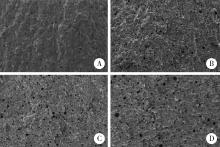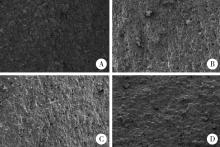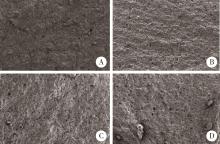北京大学学报(医学版) ›› 2023, Vol. 55 ›› Issue (1): 78-81. doi: 10.19723/j.issn.1671-167X.2023.01.011
调拌纸板厚度对玻璃离子水门汀抗压强度的影响
- 1. 北京大学口腔医学院·口腔医院综合二科,国家口腔医学中心,国家口腔疾病临床医学研究中心,口腔生物材料和数字诊疗装备国家工程研究中心,口腔数字医学北京市重点实验室,国家卫生健康委员会口腔医学计算机应用工程技术研究中心,国家药品监督管理局口腔生物材料重点实验室,北京 100081
2. 北京大学口腔医学院·口腔医院特诊科,国家口腔医学中心,国家口腔疾病临床医学研究中心,口腔生物材料和数字诊疗装备国家工程研究中心,口腔数字医学北京市重点实验室,国家卫生健康委员会口腔医学计算机应用工程技术研究中心,国家药品监督管理局口腔生物材料重点实验室,北京 100081
3. 北京大学口腔医学院·口腔医院口腔材料研究室,国家口腔医学中心,国家口腔疾病临床医学研究中心,口腔生物材料和数字诊疗装备国家工程研究中心,口腔数字医学北京市重点实验室,国家卫生健康委员会口腔医学计算机应用工程技术研究中心,国家药品监督管理局口腔生物材料重点实验室,北京 100081
Influence of paper mixing pads thickness on the compressive strength of glass ionomer cement
Qian-mei ZHOU1,Rui-yu DING2,Li LI1,Wei BAI3,Jing-ying HU1,*( )
)
- 1. Department of General Dentistry Ⅱ, Peking University School and Hospital of Stomatology & National Center of Stomatology & National Clinical Research Center for Oral Diseases & National Engineering Research Center of Oral Biomaterials and Digital Medical Devices & Beijing Key Laboratory of Digital Stomatology & NHC Research Center of Engineering and Technology for Computerized Dentistry & NMPA Key Laboratory for Dental Materials, Beijing 100081, China
2. Department of Geriatric Dentistry, Peking University School and Hospital of Stomatology & National Center of Stomatology & National Clinical Research Center for Oral Diseases & National Engineering Research Center of Oral Biomaterials and Digital Medical Devices & Beijing Key Laboratory of Digital Stomatology & NHC Research Center of Engineering and Technology for Computerized Dentistry & NMPA Key Laboratory for Dental Materials, Beijing 100081, China
3. Department of Dental Materials, Peking University School and Hospital of Stomatology & National Center of Stomatology & National Clinical Research Center for Oral Diseases & National Engineering Research Center of Oral Biomaterials and Digital Medical Devices & Beijing Key Laboratory of Digital Stomatology & NHC Research Center of Engineering and Technology for Computerized Dentistry & NMPA Key Laboratory for Dental Materials, Beijing 100081, China
摘要:
目的: 探讨调拌纸板厚度变化对玻璃离子水门汀抗压强度的影响。方法: 在相同的实验条件下,分别采用60、40、20、1张纸的纸板(P60、P40、P20、P1)对3种不同的玻璃离子水门汀进行调拌,在其凝固后进行抗压强度检测,并用扫描电镜观察不同组别材料断面气泡形成情况。结果: (1) 抗压强度:①ChemFil Superior玻璃离子材料(CF):P1组平均抗压强度最高,与P40、P60组相比差异有统计学意义(P=0.041、0.032);②而至富士IX GP玻璃离子材料(IX):P1组平均抗压强度最高,与P40、P60组相比差异有统计学意义(P=0.042、0.038);③Glaslonomer FX-Ⅱ玻璃离子材料(FX):P1组平均抗压强度最高,与P20、P40、P60组相比差异有统计学意义(P=0.031、0.040、0.041),其余各组间差异无统计学意义,三种材料均显示出随着调拌纸板厚度的下降,玻璃离子抗压强度逐渐升高,纸板厚度与玻璃离子抗压强度成高度线性负相关,CF、IX、FX相关系数分别为-0.927、-0.989、-0.892。(2)扫描电镜下观察:三种材料均显示P1组气泡最少。结论: 采用1张纸的纸板调拌玻璃离子水门汀的气泡最少,并可以获得更高的抗压强度。
中图分类号:
- R783.1
| 1 | Nicholson JW . Adhesive dental materials and their durability[J]. INT J Adhes, 2000, 20 (1): 11- 16. |
| 2 | Bayrak S , Tunc ES , Aksoy A , et al. Fluoride release and recharge from different materials used as fissure sealants[J]. Eur J Dent, 2010, 4 (3): 245- 250. |
| 3 | Fleming GCP , Farooq AA , Barralet JE . Influence of powder/liquid mixing ratio on the performance of a restorative glass-ionomer dental cement[J]. Biomaterials, 2003, 24 (23): 4173- 4179. |
| 4 | Sulaiman T , Abdulmajeed A , Altitinchi A , et al. Effect of resinmodified glass ionomer cement dispensing/mixing methods on mechanical properties[J]. J Oper Dent, 2018, 43 (4): 158- 165. |
| 5 | Singer L , Bierbaum G , Kehl K , et al. Evaluation of the antimicrobial activity and compressive strength of a dental cement modified using plant extract mixture[J]. J Mater Sci Mater Med, 2020, 31 (12): 116. |
| 6 | International Organization of Standardization. ISO 9917-1: 2007-dental-water-based cements. Part 1: Powder/liquid acid-base cements[S]. Geneva: ISO, 2016. |
| 7 | D'Alpino PH , Lopes LG , Pereira JC . Mechanical properties of dental restorative material: Relative contribution of laboratory test[J]. J Appl Oral Sci, 2003, 11 (3): 162- 167. |
| 8 | Dowling AH , Fleming GJP . Are encapsulated anterior glass-ionomer restoratives better than their hand-mixed equivalents[J]. J Dent, 2009, 37 (2): 133- 140. |
| 9 | Nomoto R , Komoriyama M , McCabe JF , et al. Effect of mixing method on the porosity of encapsulated glass ionomer cement[J]. Dent Mater, 2004, 20 (10): 972- 978. |
| 10 | Schulze KA , Zaman AA , Söderholm KJM , et al. Effect of filler fraction on strength, viscosity and porosity of experimental compomer materials[J]. J Dent, 2003, 31 (6): 373- 382. |
| 11 | Nomoto R , McCabe JF . Effect of mixing methods on the compressive strength of glass ionomer cements[J]. J Dent, 2001, 29 (3): 205- 210. |
| 12 | Kaushik M , Sharma R , Reddy P , et al. Comparative evaluation of voids present in conwentional and capsulated glass ionomer cements using two different conditions: An in vitro study[J]. Int J Biomater, 2014, 12 (3): 191- 195. |
| [1] | 胡菁颖,李莉,周倩妹,丁瑞宇,尚冉,白伟. 不同调拌板对玻璃离子水门汀物理性能的影响[J]. 北京大学学报(医学版), 2019, 51(5): 964-967. |
| [2] | 陈小贤, 刘星纲. 玻璃离子窝沟封闭剂2年临床防龋效果观察[J]. 北京大学学报(医学版), 2012, 44(1): 157-157. |
| [3] | 胡炜, 王晓灵, 王勤, 傅民魁. 正畸粘接用树脂改良型玻璃离子粘固剂的氟离子释放[J]. 北京大学学报(医学版), 2002, 34(2): 144-147. |
|
||






